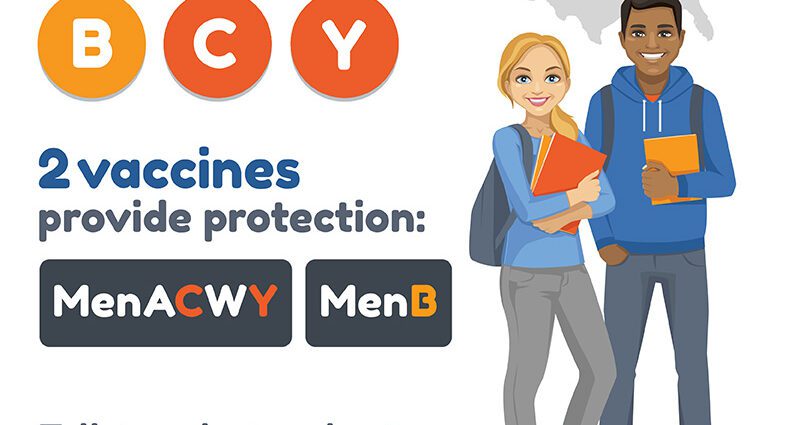Contents
Definition of meningococcal C meningitis
Meningitis is an infection of the meninges, the thin membranes that protect and surround the brain and spinal cord. There are viral meningitis, linked to a virus, bacterial meningitis, and even meningitis linked to a fungus or a parasite.
Meningococcal meningitis C is a bacterial meningitis caused by the bacteria Neisseria meningitidis, or meningococcus. Note that there are several types, or serogroups, the most common being serogroups A, B, C, W, X and Y.
In 2018 in France, according to data from the national reference center for meningococci and Haemophilus influenzae from the Institut Pasteur, among the 416 cases of meningococcal meningitis for which the serogroup was known, 51% were serogroup B, 13% C, 21% W, 13% Y and 2% rare or not serogroups “ serogroupable ”.
Invasive meningococcal infections mostly affect babies, young children, adolescents and young adults.
Meningococcal meningitis C: cause, symptoms and transmission
The bacteria Neisseria meningitidis responsible for type C meningitis is naturally present in the ENT sphere (throat, nose) from 1 to 10% of the population according to the World Health Organization, outside the epidemic period.
Transmission of the bacteria Neisseria meningitidis to an individual who was not a carrier does not systematically cause meningitis. Most of the time, the bacteria will stay in the ENT sphere and be contained by the immune system. Because the strain is particularly virulent, and / or the person has insufficient immune defenses, the bacteria sometimes diffuses into the bloodstream, reaches the meninges and causes meningitis.
We distinguish two main types of symptoms meningococcal meningitis: those falling under the meningeal syndrome (stiff neck, sensitivity to light or photophobia, disturbances of consciousness, lethargy, even coma or seizure) and those resulting from infectious syndrome (strong fever, severe headaches, nausea, vomiting….).
Some of these symptoms can be difficult to spot in a toddler, that is why a high fever should always prompt an emergency consultation, especially if the baby behaves unusually, cries incessantly or if he is in a lethargic state close to unconsciousness.
Caution : the appearance of a purpura fulminans, that is, red or purplish spots under the skin is a medical emergency and a criterion of seriousness. It requires emergency hospitalization.
How is meningococcus type C transmitted?
Meningococcal type C contamination occurs during close contact with an individual who is infected or a healthy carrier, through nasopharyngeal secretions (saliva, postilions, cough). The transmission of this bacterium is therefore favored within the family home but also, for example, in places of collective reception, because of the promiscuity between young children and the exchange of toys put in the mouth.
La incubation period, that is, the period between infection and the onset of symptoms of meningitis varies from 2 to 10 days approximately.
Treatment of meningococcal C meningitis
Treatment of an invasive meningococcal infection of any type is based on the prescription of antibiotics, intravenously or intramuscularly, and as soon as possible after the onset of symptoms. Meningococcal meningitis C requires emergency hospitalization.
Very often, in the face of symptoms suggestive of meningitis, antibiotics are administered in emergency, even if the treatment is then adapted, once a lumbar puncture has been performed to check whether it is bacterial meningitis (and of what type) or viral.
Possible complications
The earlier the meningitis is treated, the better the outcome and the less risk of sequelae.
Conversely, the absence of rapid treatment can lead to damage to other parts of the central nervous system (in particular we speak of encephalitis). The infection can also affect the whole body: this is called sepsis.
Among the possible sequelae and complications, let us quote in particular deafness, brain damage, visual or attention disturbances …
In children, prolonged surveillance is systematically put in place with healing.
Note that, according to the Health Insurance website Ameli.fr, a quarter of deaths and cases of serious sequelae linked to meningitis in children are preventable by vaccination.
Is the vaccine against meningitis type C compulsory or not?
First recommended since 2010, vaccination against meningococcal type C is now one of the 11 compulsory vaccines for all babies born on or after January 1, 2018.
He moves 65% covered by health insurance, and the remaining amount is generally reimbursed by complementary health insurance (mutuals).
It should be noted that the prevention of meningococcal C meningitis involves vaccination in order to protect the weakest subjects, in particular babies kept in community settings and who are not old enough to be vaccinated.
Meningitis C: which vaccine and which vaccination schedule?
The type of meningococcal vaccine type C depends on the baby’s age:
- for an infant, it is Neisvac® who is prescribed, and administered in two doses, at 5 months then 12 months;
- as part of a catch-up vaccination, we will opt for Neisvac® or Menjugate® in a single dose in babies of one year or more, and until the age of 24 years in the absence of primary vaccination.
sources:
- https://www.pasteur.fr/fr/centre-medical/fiches-maladies/meningites-meningocoques
- https://www.santepubliquefrance.fr/maladies-et-traumatismes/maladies-a-prevention-vaccinale/infections-invasives-a-meningocoque/la-maladie/
- https://www.has-sante.fr/upload/docs/application/pdf/2020-05/recommandation_vaccinale_contre_les_meningocoques_des_serogroupes_a_c_w_et_y_note_de_cadrage.pdf










